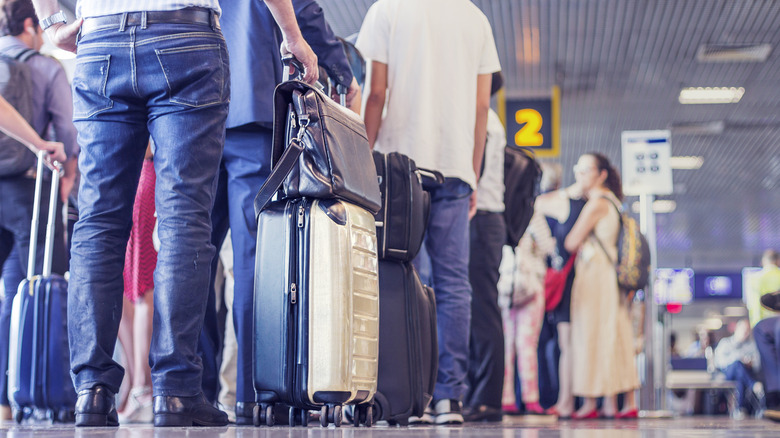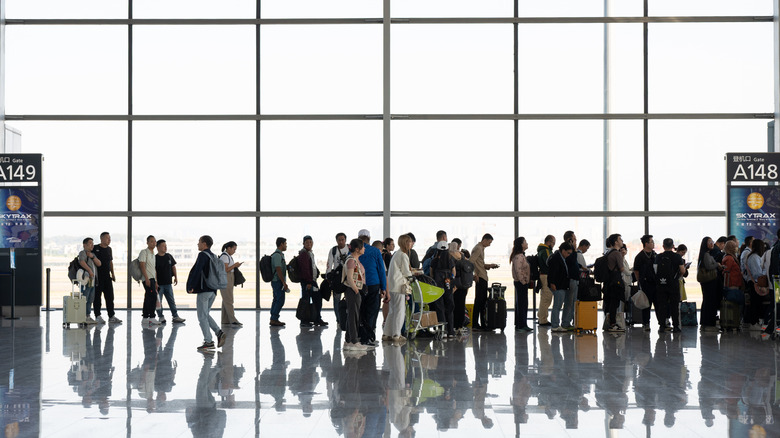Flight Attendants Have An Unflattering Nickname For Tourists Who Crowd The Boarding Gate
Airports everywhere have become infested — in their terminals, near their boarding lounges, and directly in front of their gate doors. The culprits are hordes of anxious passengers, those who crowd around gate queue entry points, hoping to board early or to be the first in line when their boarding group is called. Either way, they make it difficult for passengers with priority boarding or in earlier groups to proceed past them, and their pinched and bug-eyed faces give gate agents and airline crews a feeling of unease. In fact, flight attendants have a name for these notorious pests that they've been using amongst themselves. Such passengers are widely known as "gate lice."
The term was supposedly coined as far back as 2005, in an online forum that claimed gate lice are typically vying for precious overhead bin space to fit their carry-on bags over their seats. Perhaps they're ignorant of how airlines make their boarding groups and how to ensure they're in the best one. Perhaps they're too cheap to purchase a priority boarding upgrade. Or maybe they're new to air travel and not yet familiar with its rules of etiquette. Some Reddit users in an r/delta subreddit speculate that overcrowded terminals, delayed flights, and a lack of seating have made this an airport experience that's gotten worse and worse in recent times.
The term "lice" evokes an anxious and unwelcome infestation — though given the manner in which these passengers swarm boarding areas, practically begging to be swatted and shooed away, perhaps "gate gnats" would be a more appropriate term. It's probably no surprise that they're a problem in the U.S. more than anywhere else in the world. But why? And what is the full story behind these passengers' behavior?
Why tourists behave this way and what airlines are doing about it
It's not always these passengers' fault; air travel has become far less convenient than it was in the days when, for instance, you could smoke on a plane. More lines, more security, more people to compete with for space. In conversation with Thrillist, New York psychologist Kristie Tse revealed that this is what makes gate lice tick: their anxiety intertwined with a reciprocal need for control. "Individuals may feel an overwhelming urge to secure their position, fearing they might miss out or face consequences if they don't act quickly," she explains. "This behavior can indicate underlying insecurities or a lack of trust in the process."
And, like a swarm or any other mass subject to crowd psychology, once one person does something, others are bound to follow suit, producing a ripple effect of mimicking behavior throughout the waiting passengers. It's unsurprising that flight attendants have observed infestations to be worse in the U.S., given that Americans are notorious for overpacking their luggage. The domestic carry-on baggage size allowance is also slightly larger than that of international flights, meaning overhead bins get filled that much quicker on U.S. flights. Americans' behavior is also highly motivated by their sense of individualism and a desire to compete to get ahead.
However, regardless of why it happens, gate loitering can block boarding lanes, delay deplaning, hinder crew access, and generally slow down operations. It's more challenging for passengers who need accessibility assistance and families with small children to get through the crowds. To combat the ongoing issue, American Airlines has introduced penalties for fliers who engage in this gate agent pet peeve, while United is testing new procedures aimed at speeding up their boarding times to discourage line-jumping.

